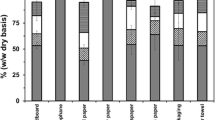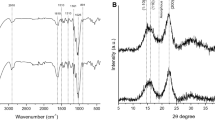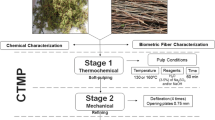Abstract
This research uses lignocellulosic waste fibers from the fiberboard industry, pulp and paper mills for their effective processing to reduce waste discharge, preserve the ecological environment, and produce innovative and sustainable solutions. The effects of using waste fibers obtained from fiberboard wet process, recycled paper process, and cellulose process as adhesive additives on some physical and mechanical properties and formaldehyde emission of adhesives and plywood panels were examined. Three major types of fibers, primary fibrous sludge (PFS), primary cellulose sludge (PCS), and deinked paper sludge (DPS) were characterized and evaluated as adhesive fillers in plywood manufacturing. UF adhesive filled with 15 wt% wheat flour (WF) was used as a reference sample. Plywood panels were made of formulations with urea-formaldehyde (UF) resin filled with three different concentrations of fibers, 1 wt%, 3 wt%, and 5 wt%. Compared with DPS and PCS, PFS had a higher lignin and extractives content, and lower pH. These characteristics make PFS a better adhesive filler for plywood than DPS or PCS. Panels with UF/PFS, UF/DPS and UF/PCS formulations at a sludge content of 1–5 wt%, 1 wt% and 3 wt%, respectively had higher wet shear strengths than those made with the control sample. It was also found that the use of fibers obtained from different processes in the UF adhesive composition decreased the formaldehyde emission of panels. The PFS, PCS, and DPS reduced formaldehyde emissions by up to 27.8, 24.9, and 19.4%, respectively compared with control panels, without compromising the shear strength. The shear strength of plywood panels with all investigated sludges met the requirements of the EN 314-2 standard.








Similar content being viewed by others
References
Abdullah R, Ishak CF, Kadir WR, Bakar RA (2015) Characterization and feasibility assessment of recycled paper mill sludges for land application in relation to the environment. Int J Environ Res Public Health 12(8):9314–9329
ASTM D1200–10 (2018) Standard test method for viscosity by ford viscosity cup. ASTM International, West Conshohocken
Basta AH, El-Saied H, Gobran RH (2004) Formaldehyde–free environmentally friendly composites based on agricultural waste. I. Novel adhesive system. Polym Plast Technol Eng 43(3):745–777
Basta AH, El-Saied H, Gobran RH, Sultan MZ (2006) Enhancing environmental performance of formaldehyde-based adhesives in lignocellulosic composites, part III: evaluation of some starch derivatives. Des Monomers Polym 9:325–347
Basta AH, El-Saied H, Winandy JE, Sabo R (2011) Preformed amide-containing biopolymer for improving the environmental performance of synthesized urea–formaldehyde in agro-fiber composites. J Polym Environ 19(2):405–412
Basta AH, El-Saied H, Baraka AM, Lotfy VF (2017a) Beneficial effect of new activated carbons in enhancing the performance of particle boards from UF-rice straw. Pigm Resin Technol 46(2):139–147
Basta AH, El-Saied H, Baraka AM, Lotfy VF (2017b) Performance of carbon xerogels in the production of environmentally friendly urea formaldehyde-bagasse composites. Clean Soil Air Water 45:6. https://doi.org/10.1002/clen.201600524
Beauchamp CJ, Charest MH, Gosselin A (2002) Examination of environmental quality of raw and composting de-inking paper sludge. Chemosphere 46:887–895
Benar P, Mandelli D, Gonçalves ARC, Ferreria MMC, Schuchardt U (1999) Principal component analisis on the hydroxymethylation of sugarcane lignin: a time-depending study by FTIR. J Wood Chem Technol 19(1–2):151–165
Boran S, Usta M, Gümüşkaya E (2011) Decreasing formaldehyde emission from medium density fiberboard panels produced by adding different amine compounds to urea formaldehyde resin. Int J Adhes Adhes 31(7):674–678
Boran S, Usta M, Ondaral S, Gümüşkaya E (2012) The efficiency of tannin as a formaldehyde scavenger chemical in medium density fiberboard. Compos B 43(5):2487–2491
Costa NA, Pereira J, Ferra J, Cruz P, Martins J, Magalhгes FD, Mendes A, Carvalho LH (2013) Scavengers for achieving zero formaldehyde emission of wood-based panels. Wood Sci Technol 47:1261–1272
Davis E, Shaler SM, Goodell B (2003) The incorporation of paper deinking sludge into fiberboard. Forest Prod J 53:46–54
De Jong JI, De Jonge J (1953) Kinetics of the hydroxymethylation of phenols in dilute aqueous solution. Recl Trav Chim Pays-Bas 72(6):497–509
Dijkstra R, De Jonge J, Lammers MF (1962) The kinetics of the reaction of phenol and formaldehyde. Recl Trav Chim Pays-Bas 81(4):285–296
Ding W, Li W, Gao Q, Han C, Zhang S, Li J (2013) The effects of sealing treatment and wood species on formaldehyde emission of plywood. BioResources 8:2568–2582
Dunky M (1998) Urea-formaldehyde (UF) adhesive resins for wood. Int J Adhes Adhes 18(2):95–107
Edalatmanesh M, Sain M, Liss SN (2010) Cellular biopolymers and molecular structure of a secondary pulp and paper mill sludge verified by spectroscopy and chemical extraction techniques. Water Sci Technol 62(12):2846–2853
Elloumi A, Makhlouf M, Elleuchi A, Bradai Ch (2016a) Deinking sludge (DS), a new bio-filler for HDPE composites. Polym Plast Technol Eng 55:1012–1020
Elloumi A, Makhlouf M, Elleuchi A, Bradai Ch (2016b) The potential of deinking paper sludge for recycled HDPE reinforcement. Polym Compos. https://doi.org/10.1002/pc.23975
EN 314-1 (2004) Plywood. Bonding quality. Part 1: test methods. European Committee for Standardization, Brussels
EN 314-2 (1993) Plywood. Bonding quality. Part 2: requirements. European Committee for Standardization, Brussels
Eom Y-G, Kim J-S, Kim S, Kim J-A, Kim H-J (2006) Reduction of formaldehyde emission from particleboards by bio-scavengers. Mokchae Konghak 34:29–41
European Commission (2008) Environmental, economic and social impacts of the use of sewage sludge on land. Final report. Part I: overview report. Milieu Ltd. (Belgium), Study Contract DG ENV.G.4/ETU/2008/0076r. http://ec.europa.eu/environment/archives/waste/sludge/pdf/part_i_report.pdf
Gangi M, Tabarsa T, Sepahvand S, Asghari J (2013) Reduction of formaldehyde emission from plywood. J Adhes Sci Technol 27(13):1407–1417
Gao Z, Wang X-M, Wan H, Liu Y (2008) Curing characteristics of urea-formaldehyde resin in the presence of various amounts of wood extracts and catalysts. J Appl Polym Sci 107:1555–1562
Gardner DJ, McGinnis GD (1988) Comparison of the reaction rates of the alkali-catalyzed addition of formaldehyde to phenol and selected lignins. J Wood Chem Technol 8(2):261–288
Geng X, Deng J, Zhang SY (2006) Effects of hot-pressing parameters and wax content on the properties of fiberboard made from paper mill sludge. Wood Fiber Sci 38:736–741
Geng X, Deng J, Zhang SY (2007a) Paper mill sludge as a component of wood adhesive formulation. Holzforschung 61:688–692
Geng XL, Zhang SY, Deng J (2007b) Characteristics of paper mill sludge and its utilization for the manufacture of medium density fiberboard. Wood Fiber Sci 39:345–351
Grigoriou A (1987) Formaldehyde emission from the edges and faces of various wood based materials. Holz Roh Werkst 45(2):63–67
Gui C, Zhu J, Zhang Z, Liu X (2016) Research progress on formaldehyde-free wood adhesive derived from soy flour. In: Rudawska A (ed) Adhesives—applications and properties. IntechOpen, London. https://doi.org/10.5772/65502
Hamzeh Y, Ashori A, Mirzaei B (2011) Effects of waste paper sludge on the physico-mechanical properties of high density polyethylene/wood flour composites. J Polym Environ 19:120–124
Hu J, Tian D, Renneckar S, Saddler JN (2018) Enzyme mediated nanofibrillation of cellulose by the synergistic actions of an endoglucanase, lytic polysaccharide monooxygenase (LPMO) and xylanase. Sci Rep 8(1):3195
IARC (2006) Monographs on the evaluation of carcinogenic risk to humans. Vol 88. Formaldehyde, 2-butoxyethanol and 1-tert-butoxypropan-2-ol. European Committee for Standardization, World Health Organization—International Agency for Research on Cancer
ISO 11402 (2004) Phenolic, amino and condensation resins—determination of free-formaldehyde content. International Organization for Standardization, Geneva
JIS A 1460 (2001) Building boards determination of formaldehyde emission—desiccator method. Japanese Industrial Standards Committee, Tokyo
Johns WE, Niazi KA (1980) Effect of pH and buffering capacity of wood on the gelation time of urea-formaldehyde resin. Wood Fiber 12(4):255–263
Kamath YK, Hornby SB, Weigmann HD (1985) Irreversible chemisorption of formaldehyde on cotton cellulose. Textile Res J 55(11):663–666
Karim Z, Mathew AP, Kokol V, Wei J, Grahn M (2016) High-flux affinity membranes based on cellulose nanocomposites for removal of heavy metal ions from industrial effluents. RSC Adv 6(25):20644–20653
Kim S (2009a) Environment-friendly adhesives for surface bonding of wood-based flooring using natural tannin to reduce formaldehyde and TVOC emission. Bioresour Technol 100:744–748
Kim S (2009b) The reduction of indoor air pollutant from wood-based composite by adding pozzolan for building materials. Constr Build Mater 23(6):2319–2323
Kim S, Kim HJ, Kim HS, Lee HH (2006) Effect of bio-scavengers on the curing behavior and bonding properties of melamine-formaldehyde resins. Macromol Mater Eng 291(9):1027–1034
Kmec S, Sedliacik J, Smidriakova M, Jablonski M (2010) Zeolite as a filler of UF resin for lower formaldehyde emission from plywood. Ann Warsaw Univ Life Sci 70:161–165
Łebkowska M, Załęska-Radziwiłł M, Tabernacka A (2017) Adhesives based on formaldehyde—environmental problems. BioTechnologia 98(1):53–65
Lee S-H, Chang F, Inoue S, Endo T (2010) Increase in enzyme accessibility by generation of nanospace in cell wall supramolecular structure. Bioresour Technol 101(19):7218–7223
Mahmood T, Elliott A (2006) A review of secondary sludge reduction technologies for the pulp and paper industry. Water Res 40:2093–2112
Malutan T, Nicu R, Popa VI (2008) Contribution to the study of hydroxymethylation reaction of alkali lignin. BioResources 3(1):13–20
Migneault S, Koubaa A, Riedl B, Nadji H, Deng J, Zhang SY (2011a) Binderless fiberboard made from primary and secondary pulp and paper sludge. Wood Fiber Sci 43:180–193
Migneault S, Koubaa A, Riedl B, Nadji H, Deng J, Zhang T (2011b) Potential of pulp and paper sludge as a formaldehyde scavenger agent in MDF resins. Holzforschung 65:403–409
Monte MC, Fuente E, Blanco A, Negro C (2009) Waste management from pulp and paper production in the European Union. Waste Manag 29:293–308
Moubarik A, Allal A, Pizzi A, Charreir B, Carreir F (2010) Characterization of a formaldehyde-free cornstarch-tannin wood adhesive for interior plywood. Eur J Wood Prod 68:427–433
Myers GE (1984) How mole ratio of UF resin affects formaldehyde emission and other properties: a literature critique. Forest Prod J 34:35–41
Myers GE (1986) Effects of post-manufacture board treatments on formaldehyde emission: a literature review (1960–1984). Forest Prod J 36:41–51
Nemli G (2003) Effects of coating materials process parameters on the technological properties of particleboard. PhD Dissertation thesis, Karadeniz Teknik University, Trabzon, Turkey
Park BD, Kang EC, Park JY (2008) Thermal curing behavior of modified urea-formaldehyde resin adhesives with two formaldehyde scavengers and their influence on adhesion performance. J Appl Polym Sci 110(3):1573–1580
Pervaiz M, Sain M (2011) Protein extraction from secondary sludge of paper mill wastewater and its utilization as a wood adhesive. BioResources 6:961–970
Pizzi A, Mittal KL (2003) Handbook of adhesive technology, 2nd edn. Marcel Dekker, New York, p 672
Poletto M, Zattera AJ, Santana R (2012) Structural differences between wood species: evidence from chemical composition, FTIR spectroscopy, and thermogravimetric analysis. J Appl Polym Sci 126:S1
Raquez J-M, Deléglise M, Lacrampe M-F, Krawczak P (2010) Thermosetting (bio)materials derived from renewable resources: a critical review. Prog Polym Sci 35(4):487–509
Reig FB, Adelantado JVG, Moreno MCMM (2002) FTIR quantitative analysis of calcium carbonate (calcite) and silica (quartz) mixtures using the constant ratio method. Application to geological samples. Talanta 58(4):811–821
Robertson JE, Robertson RRP (1977) Review of filler and extender quality evaluation. Forest Prod J 27:30–38
Roffael E (1982) Die Formaldehydabgabe von Spanplatten und anderen Werkstoffen [The release of formaldehyde from particleboards and other materials]. DRW, Stuttgart
Roffael E (2006) Volatile organic compounds and formaldehyde in nature, wood and wood based panels. Holz Roh Werkst 64:144–149
Roffael E (2016) Significance of wood extractives for wood bonding. Appl Microbiol Biotechnol 100:1589–1596
Rowell RM (2005) Handbook of chemistry and wood composites. CRC Press, Boca Raton, p 446
Sastry GP (1969) The reaction of formaldehyde with spruce lignins. Holzforschung 23(1):15–17
Seifert VK (1956) Über ein neues Verfahren zur Schnellbestimmung der Rein—Cellulose. Papier 10:301–306
Sluiter A, Ruiz R, Scarlata C, Sluiter J, Templeton D (2008a). Determination of extractives in biomass: Laboratory Analytical Procedure (LAP). NREL/TP-510-42619. National Renewable Energy Laboratory, Golden, CO
Sluiter A, Hames B, Ruiz R, Scarlata C, Sluiter J, Templeton D (2008b) Determination of ash in biomass. Technical Report NREL/TP-510-42622. National Renewable Energy Laboratory Golden, CO
Sluiter A, Hames B, Ruiz R, Scarlata C, Sluiter J, Templeton D, Crocker D (2011) Determination of structural carbohydrates and lignin in biomass: Laboratory Analytical Procedure (LAP). NREL/TP-510-42618. National Renewable Energy Laboratory, Golden, CO
Son J, Yang HS, Kim HJ (2004) Physico-mechanical properties of paper sludge-thermoplastic polymer composites. J Thermoplast Compos Mater 17:509–522
Stefke B, Dunky M (2006) Catalytic influence of wood on the hardening behavior of formaldehyde based resin adhesives used for wood-based panels. J Adhes Sci Technol 20(8):761–785
Taherzadeh MJ, Karimi K (2008) Pretreatment of lignocellulosic wastes to improve ethanol and biogas production: a review. Int J Mol Sci 9:1621–1651
Taramian A, Doosthoseini K, Mirshokraii SA, Faezipour M (2007) Particleboard manufacturing: an innovative way to recycle paper sludge. Waste Manag 27:1739–1746
Vazquez G, Freire S, Rodriguez-Bona C, Gonzalez J, Antorrena G (1999) Structures, and reactivities with formaldehyde, of some acetosolv pine lignins. J Wood Chem Technol 19(4):357–378
Williams RS (2010) Finishing of wood. In: Wood handbook. U.S. Department of Agriculture, Forest Service, Forest Products Laboratory, General Technical Report FPL-GTR-190. Madison, Chapter 16, pp 16-1–16-39
Wise LE, Murphy M, D’addieco AA (1946) Chlorite holocellulose, its fractionation and bearing on summative wood analysis and on studies on the hemicelluloses. Pap Trade J 122(2):35–43
Xing S, Riedl B, Koubaa A, Deng J (2012) Mechanical and physical properties of particleboard made from two pulp and paper mill secondary sludges. World J Eng 9:31–36
Xing S, Riedl B, Deng J, Nadji H, Koubaa A (2013) Potential of pulp and paper secondary sludge as co-adhesive and formaldehyde scavenger for particleboard manufacturing. Eur J Wood Prod 71:705–716
Acknowledgements
The authors acknowledge COST Action CA15216 “European Network of Bioadhesion Expertise: Fundamental Knowledge to Inspire Advanced Bonding Technologies” for support of ECOST-STSM-CA15216-010517-088783. Special thanks are extended to M.Sc. I. Salabay for determining the properties of the adhesives. This research was supported by the Slovak Research and Development Agency under the contract no. APVV-14-0506.
Author information
Authors and Affiliations
Corresponding author
Ethics declarations
Conflict of interest
On behalf of all authors, the corresponding author states that there is no conflict of interest.
Additional information
Publisher’s Note
Springer Nature remains neutral with regard to jurisdictional claims in published maps and institutional affiliations.
Rights and permissions
About this article
Cite this article
Bekhta, P., Sedliačik, J., Kačík, F. et al. Lignocellulosic waste fibers and their application as a component of urea-formaldehyde adhesive composition in the manufacture of plywood. Eur. J. Wood Prod. 77, 495–508 (2019). https://doi.org/10.1007/s00107-019-01409-8
Received:
Published:
Issue Date:
DOI: https://doi.org/10.1007/s00107-019-01409-8




